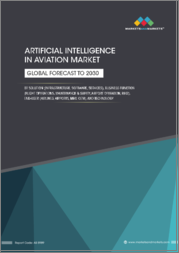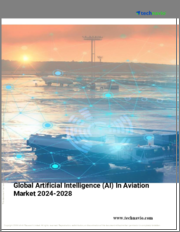
|
시장보고서
상품코드
1666025
세계의 항공 업계 인공지능(AI) 시장 규모, 점유율, 성장 분석 : 컴포넌트별, 기술별, 용도별, 지역별 - 산업 예측(2025-2032년)Artificial Intelligence in Aviation Market Size, Share, and Growth Analysis, By Component (Hardware, Software), By Technology (Machine Learning, Natural Language Processing), By Application, By Region - Industry Forecast 2025-2032 |
||||||
항공 업계 인공지능(AI) 세계 시장 규모는 2023년 46억 달러로 평가되었고, 예측 기간(2025-2032년) 동안 연평균 21.1%의 연평균 복합 성장률(CAGR)로 2024년 55억 7,000만 달러에서 2032년에는 257억 7,000만 달러로 성장할 것으로 예상됩니다.
항공우주 산업이 빅데이터 분석과 클라우드 기반 기술을 점점 더 많이 채택함에 따라 항공 분야의 인공지능(AI) 세계 시장은 크게 성장할 것으로 예상되며, AI에 대한 투자는 항공 업무를 빠르게 변화시키고 공항과 항공사의 고객 서비스를 개선하고 있습니다. 운영 비용의 상승과 수익성 추구는 이러한 기술 통합을 촉진하고 있으며, 항공권 예약용 AI 기반 챗봇과 같은 혁신을 통해 여행자 경험을 향상시키고 있습니다. 또한, 향후 AI와 머신러닝의 예측 유지보수 및 항공관제 분야에도 적용될 것으로 예상됩니다. AI의 발전이 계속되고 연구 자금이 확대됨에 따라 컴퓨터 비전, 자연어 처리, 시계열 분석과 같은 기술을 채택하여 복잡한 항공 프로세스를 간소화하는 데 있어 AI의 역할이 크게 확대될 것으로 예상됩니다.
목차
서론
- 조사 목적
- 조사 범위
- 정의
조사 방법
- 정보 조달
- 2차와 1차 데이터 방법
- 시장 규모 예측
- 시장 전제조건과 제한
주요 요약
- 세계 시장 전망
- 공급과 수요 동향 분석
- 부문별 기회 분석
시장 역학과 전망
- 시장 개요
- 시장 규모
- 시장 역학
- 성장 촉진요인과 기회
- 성장 억제요인과 과제
- Porter의 Five Forces 분석
주요 시장 인사이트
- 중요 성공 요인
- 경쟁 정도
- 주요 투자 기회
- 시장 생태계
- 시장의 매력 지수(2024년)
- PESTEL 분석
- 거시경제 지표
- 밸류체인 분석
- 가격 분석
- 규제 상황
- 사례 연구
- 기술 진보
항공 업계 인공지능(AI) 시장 규모 : 컴포넌트별&CAGR(2025-2032년)
- 시장 개요
- 하드웨어
- 소프트웨어
- 서비스
항공 업계 인공지능(AI) 시장 규모 : 기술별&CAGR(2025-2032년)
- 시장 개요
- 머신러닝
- 자연언어처리
- 상황인식 컴퓨팅
- 컴퓨터 비전
항공 업계 인공지능(AI) 시장 규모 : 용도별&CAGR(2025-2032년)
- 시장 개요
- 가상 비서
- 스마트 메인터넌스
- 제조업
- 트레이닝
- 감시
- 비행 업무
- 동적 가격 책정
- 기타
항공 업계 인공지능(AI) 시장 규모 : 지역별&CAGR(2025-2032년)
- 북미
- 미국
- 캐나다
- 유럽
- 독일
- 스페인
- 프랑스
- 영국
- 이탈리아
- 기타 유럽
- 아시아태평양
- 중국
- 인도
- 일본
- 한국
- 기타 아시아태평양
- 라틴아메리카
- 브라질
- 기타 라틴아메리카
- 중동 및 아프리카
- GCC 국가
- 남아프리카공화국
- 기타 중동 및 아프리카
경쟁 정보
- 주요 5개사 비교
- 주요 기업의 시장 포지셔닝(2024년)
- 주요 시장 기업이 채택한 전략
- 최근 시장 동향
- 기업의 시장 점유율 분석(2024년)
- 주요 기업 개요
- 기업 상세
- 제품 포트폴리오 분석
- 기업 부문별 점유율 분석
- 매출 전년대비 비교(2022-2024)
주요 기업 개요
- Honeywell Aerospace(United States)
- Embention Sistemas Inteligentes S.A(Spain)
- SIA Engineering Company(Singapore)
- ST Engineering Aerospace(Singapore)
- CAE Inc.(Canada)
- Dassault Systemes(France)
- Thales Group(France)
- BAE Systems(United Kingdom)
- Raytheon Technologies(United States)
- Northrop Grumman(United States)
- Lockheed Martin(United States)
- General Electric Aviation(United States)
- Safran(France)
- Leonardo S.p.A.(Italy)
- Rolls-Royce Holdings(United Kingdom)
- Elbit Systems(Israel)
- L3Harris Technologies(United States)
- Kongsberg Gruppen(Norway)
결론과 제안
LSH 25.04.03Global Artificial Intelligence in Aviation Market size was valued at USD 4.6 billion in 2023 and is poised to grow from USD 5.57 billion in 2024 to USD 25.77 billion by 2032, growing at a CAGR of 21.1% during the forecast period (2025-2032).
The global artificial intelligence (AI) market in aviation is poised for substantial growth as the aerospace industry increasingly adopts big data analytics and cloud-based technologies. Investments in AI are rapidly transforming aviation operations and improving customer service at airports and airlines. Rising operational costs and the pursuit of profitability are driving this technology integration, which enhances traveler experiences through innovations like AI-powered chatbots for ticket bookings. Additionally, the future promises greater applications of AI and machine learning in predictive maintenance and air traffic control. As advancements continue and research funding escalates, AI's role in streamlining complex aviation processes-employing techniques like computer vision, natural language processing, and time series analysis-is expected to expand significantly.
Top-down and bottom-up approaches were used to estimate and validate the size of the Global Artificial Intelligence In Aviation market and to estimate the size of various other dependent submarkets. The research methodology used to estimate the market size includes the following details: The key players in the market were identified through secondary research, and their market shares in the respective regions were determined through primary and secondary research. This entire procedure includes the study of the annual and financial reports of the top market players and extensive interviews for key insights from industry leaders such as CEOs, VPs, directors, and marketing executives. All percentage shares split, and breakdowns were determined using secondary sources and verified through Primary sources. All possible parameters that affect the markets covered in this research study have been accounted for, viewed in extensive detail, verified through primary research, and analyzed to get the final quantitative and qualitative data.
Global Artificial Intelligence In Aviation Market Segments Analysis
Global Artificial Intelligence in Aviation Market is segmented by Component, Technology, Application and region. Based on Component, the market is segmented into Hardware, Software and Services. Based on Technology, the market is segmented into Machine Learning, Natural Language Processing, Context Awareness Computing and Computer Vision. Based on Application, the market is segmented into Virtual Assistants, Smart Maintenance, Manufacturing, Training, Surveillance, Flight Operations, Dynamic Pricing and Others. Based on region, the market is segmented into North America, Europe, Asia Pacific, Latin America and Middle East & Africa.
Driver of the Global Artificial Intelligence In Aviation Market
The Global Artificial Intelligence in Aviation market is driven by the industry's commitment to improving operational efficiency through automation of intricate processes, including flight scheduling, route optimization, and predictive maintenance. By leveraging AI, airlines can analyze data in real-time, which significantly speeds up decision-making and minimizes costs. The integration of artificial intelligence is a strategic initiative that helps airlines stay competitive in a rapidly evolving aviation landscape. These advanced technologies enable effective resource management, reduce operational downtime, and provide solutions to various industry challenges, fostering a more agile and responsive approach to aviation operations.
Restraints in the Global Artificial Intelligence In Aviation Market
The Global Artificial Intelligence in Aviation market faces notable constraints due to the necessity of processing vast amounts of sensitive passenger and operational data. This requirement heightens concerns regarding potential data breaches, unauthorized access, and adherence to privacy regulations, which may deter airlines and airports from adopting AI technologies. To mitigate these apprehensions and enhance the adoption rate of AI solutions in the sector, it is crucial to implement robust data encryption measures, ensure strict compliance with privacy laws, and establish transparent guidelines for data usage. Addressing these challenges is vital for fostering trust and encouraging the integration of AI in aviation.
Market Trends of the Global Artificial Intelligence In Aviation Market
The Global Artificial Intelligence in Aviation market is witnessing a significant surge, driven by the integration of AI and IoT technologies. This transformative convergence enhances real-time monitoring of aircraft systems, baggage management, and passenger services, creating an ecosystem marked by operational accuracy and efficiency. AI leverages data from IoT sensors to predict maintenance needs, optimize fuel utilization, and minimize disruptions. As airlines and airport authorities adopt these sophisticated solutions, the market is set for robust growth, paving the way for automated systems and the evolution of smart airports, significantly reshaping the future of air travel and operations.
Table of Contents
Introduction
- Objectives of the Study
- Scope of the Report
- Definitions
Research Methodology
- Information Procurement
- Secondary & Primary Data Methods
- Market Size Estimation
- Market Assumptions & Limitations
Executive Summary
- Global Market Outlook
- Supply & Demand Trend Analysis
- Segmental Opportunity Analysis
Market Dynamics & Outlook
- Market Overview
- Market Size
- Market Dynamics
- Drivers & Opportunities
- Restraints & Challenges
- Porters Analysis
- Competitive rivalry
- Threat of substitute
- Bargaining power of buyers
- Threat of new entrants
- Bargaining power of suppliers
Key Market Insights
- Key Success Factors
- Degree of Competition
- Top Investment Pockets
- Market Ecosystem
- Market Attractiveness Index, 2024
- PESTEL Analysis
- Macro-Economic Indicators
- Value Chain Analysis
- Pricing Analysis
- Regulatory Landscape
- Case Studies
- Technological Advancement
Global Artificial Intelligence in Aviation Market Size by Component & CAGR (2025-2032)
- Market Overview
- Hardware
- Software
- Services
Global Artificial Intelligence in Aviation Market Size by Technology & CAGR (2025-2032)
- Market Overview
- Machine Learning
- Natural Language Processing
- Context Awareness Computing
- Computer Vision
Global Artificial Intelligence in Aviation Market Size by Application & CAGR (2025-2032)
- Market Overview
- Virtual Assistants
- Smart Maintenance
- Manufacturing
- Training
- Surveillance
- Flight Operations
- Dynamic Pricing
- Others
Global Artificial Intelligence in Aviation Market Size & CAGR (2025-2032)
- North America (Component, Technology, Application)
- US
- Canada
- Europe (Component, Technology, Application)
- Germany
- Spain
- France
- UK
- Italy
- Rest of Europe
- Asia Pacific (Component, Technology, Application)
- China
- India
- Japan
- South Korea
- Rest of Asia-Pacific
- Latin America (Component, Technology, Application)
- Brazil
- Rest of Latin America
- Middle East & Africa (Component, Technology, Application)
- GCC Countries
- South Africa
- Rest of Middle East & Africa
Competitive Intelligence
- Top 5 Player Comparison
- Market Positioning of Key Players, 2024
- Strategies Adopted by Key Market Players
- Recent Developments in the Market
- Company Market Share Analysis, 2024
- Company Profiles of All Key Players
- Company Details
- Product Portfolio Analysis
- Company's Segmental Share Analysis
- Revenue Y-O-Y Comparison (2022-2024)
Key Company Profiles
- Honeywell Aerospace (United States)
- Company Overview
- Business Segment Overview
- Financial Updates
- Key Developments
- Embention Sistemas Inteligentes S.A (Spain)
- Company Overview
- Business Segment Overview
- Financial Updates
- Key Developments
- SIA Engineering Company (Singapore)
- Company Overview
- Business Segment Overview
- Financial Updates
- Key Developments
- ST Engineering Aerospace (Singapore)
- Company Overview
- Business Segment Overview
- Financial Updates
- Key Developments
- CAE Inc. (Canada)
- Company Overview
- Business Segment Overview
- Financial Updates
- Key Developments
- Dassault Systemes (France)
- Company Overview
- Business Segment Overview
- Financial Updates
- Key Developments
- Thales Group (France)
- Company Overview
- Business Segment Overview
- Financial Updates
- Key Developments
- BAE Systems (United Kingdom)
- Company Overview
- Business Segment Overview
- Financial Updates
- Key Developments
- Raytheon Technologies (United States)
- Company Overview
- Business Segment Overview
- Financial Updates
- Key Developments
- Northrop Grumman (United States)
- Company Overview
- Business Segment Overview
- Financial Updates
- Key Developments
- Lockheed Martin (United States)
- Company Overview
- Business Segment Overview
- Financial Updates
- Key Developments
- General Electric Aviation (United States)
- Company Overview
- Business Segment Overview
- Financial Updates
- Key Developments
- Safran (France)
- Company Overview
- Business Segment Overview
- Financial Updates
- Key Developments
- Leonardo S.p.A. (Italy)
- Company Overview
- Business Segment Overview
- Financial Updates
- Key Developments
- Rolls-Royce Holdings (United Kingdom)
- Company Overview
- Business Segment Overview
- Financial Updates
- Key Developments
- Elbit Systems (Israel)
- Company Overview
- Business Segment Overview
- Financial Updates
- Key Developments
- L3Harris Technologies (United States)
- Company Overview
- Business Segment Overview
- Financial Updates
- Key Developments
- Kongsberg Gruppen (Norway)
- Company Overview
- Business Segment Overview
- Financial Updates
- Key Developments














